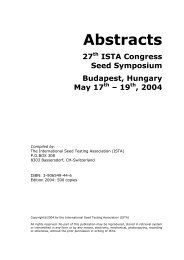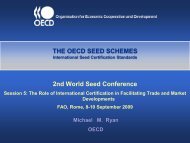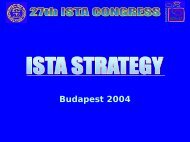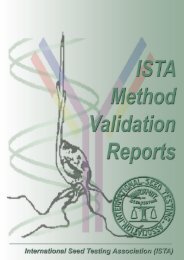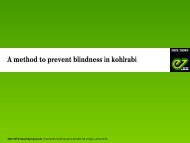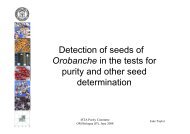Historical Paper - Volume 2 2008 - International Seed Testing ...
Historical Paper - Volume 2 2008 - International Seed Testing ...
Historical Paper - Volume 2 2008 - International Seed Testing ...
Create successful ePaper yourself
Turn your PDF publications into a flip-book with our unique Google optimized e-Paper software.
H.A. JENSEN<br />
Before an effective size grading was introduced in cleaning of Beta, it was due to<br />
different sizes of the clusters, difficult to obtain a representative sample for the germination<br />
analyses. Aiming to overcome this problem, the Rules of 1938 prescribed that from a<br />
sample of 50g all extraneous matter should be removed and the remaining part of the<br />
sample divided into 5 fractions by a set of sieves with 5, 4, 3 and 2.5mm slits. The<br />
clusters retained in each sieve should be counted, and the number of clusters to be taken<br />
from each sieve should be calculated, aiming to obtaining the 100 clusters necessary for<br />
each replicate in the germination test.<br />
The Beet <strong>Seed</strong> Committee tried various methods for drawing pure seed for germination,<br />
but was not able at this stage to recommend a method, which could replace the timeconsuming<br />
sieving and counting method (Stahl 1950a).<br />
Improved cleaning techniques reduced the problem, and since 1966 pure seed for<br />
germination have been obtained from the pure seed fraction. The use of the 2mm sieves<br />
in purity analysis of Beta was removed from the ISTA Rules in 1995 to harmonise with<br />
the AOSA Rules<br />
The use of sieves as an aid in purity and number count analyses has always been a<br />
standard procedure at most seed testing laboratories. In Norway, for example, a sieve is<br />
shown on a photo of the purity laboratory taken around 1930 (Ellingsberg et al., 1984).<br />
7.2 Size grading<br />
After introduction of monogerm Beta seeds, which were planted by precise drilling<br />
machines, a uniform size of the seeds and the seed pellets became important. Therefore,<br />
seed grading became part of the ISTA Rules of 1976 (Appendix A).<br />
In the Rules it is stated that “The ‘Bonn’ Screening apparatus…with the requisite<br />
round-hole screens and automatic switch-gear for regular interruption of the reciprocations<br />
may be used.”<br />
This is one of the few cases where a specific brand is mentioned in the ISTA Rules.<br />
The reason is, most likely, that is was a problem with different brands of screening<br />
apparatus to obtain uniform results between laboratories.<br />
A uniform and precise size of the holes in the sieves, used for the size grading, is also<br />
very important for reproducing the results. A method to test the reliability of the sieves,<br />
used for size grading, was developed by Kruse and Steiner (1994).<br />
7.3 Image analyses (seed scanner)<br />
Westerlind (1988) described the development of a seed scanner, a computer–based device<br />
for determination of other seeds by number in cereal seeds. The seed scanner sorted<br />
the seed sample into two fractions. One fraction contained typical seeds of the species<br />
examined and the other deviating seeds and various impurities. Only the latter fraction,<br />
usually representing only 0-15 pct. of the sample, needed to be examined by the analyst.<br />
The seed scanner combined with manual examination could be calibrated to work with<br />
at least the same accuracy as samples tested by manual analyses. A considerable amount<br />
of time could be saved when the seed scanner was used on cereals. The system has been<br />
used since 1988 at five Swedish seed testing laboratories and later in Norway, Denmark<br />
and in a few other countries.<br />
26



